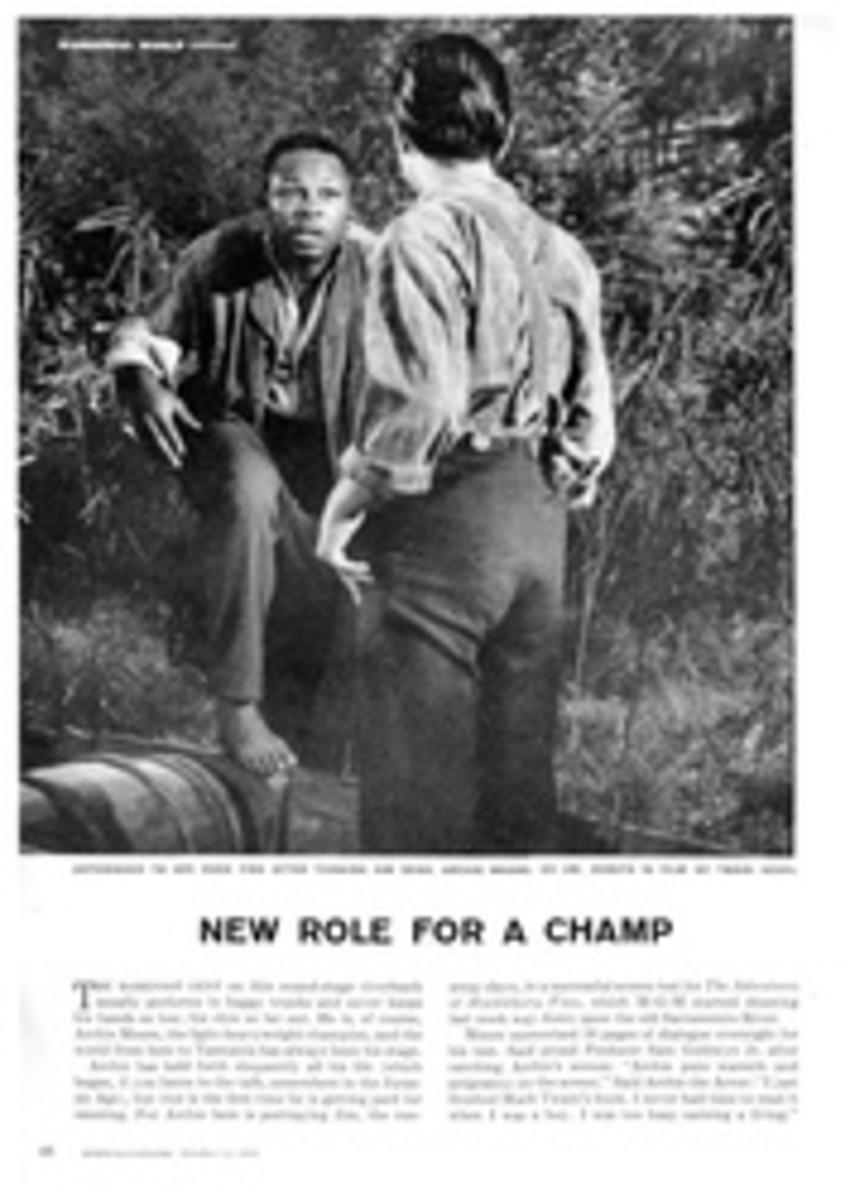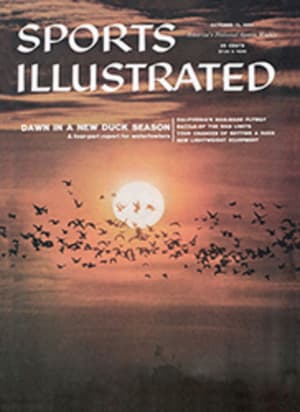
Delights of Drifting Down the Delaware
When the sentinel sycamores shed their yellow tatters and show their skeletons, when the oak-and maple-cloaked valley ramparts come all afire—in a word, when Indian summer truly arrives, then is the time for float-fishing down the Delaware. It is a sport as old and adventuresome as the Indians, and almost as forgotten. Take live minnows if you can, then hellgrammites, craws, grasshoppers or bass bugs, and always lamprey eels. If you can't gel live bait, go anyway with spinners and imitations. But do not miss float-fishing. For that golden idle moment between when the trout peter out and the woodcock tweeter in, there is nothing quite like it.
Have you ever stood beside a fishing water and wished it might suddenly evaporate, go completely dry for just a moment so you could behold all the monsters and curiosities it must contain?
Purse-seining, skin-diving, bathy-sphering are all motivated by this same totality of curiosity. And there is float-fishing. True, it is less penetrating than the others, but it is deeply satisfying because it gives you time to absorb all the wonders of the upper world around you while you probe the mysteries below. It is a pastime esteemed highly by sportsmen of true curiosity, patience and perception.
Mid-continent fishermen, especially in the Ozarks, have long known and practiced the art. It is the simplest and most rewarding way to handle a big river. Instead of trying to pick your spots in a massive flow of water, over unlimited feeding grounds, you commit your life and luck to the river's immemorial currents. You present your lure continuously to a whole, imponderable fish population instead of in snatches to a few fish here and there.
Float-fishing does not mean simply putting a bobber on your line to signal the bites, though it can include this. It means putting your boat—canoe, oared skiff or outboard—into a good-sized river and resolving to drift wherever the river listeth, not just for a few hours but for a day, or for two or three days.
You tarry at this rift, back eddy, sunken tree or log jam. You go ashore to gather bait or take a snooze. You step out of your craft to cast from a promising rock ledge, or detour into the mouth of a feeder brook. You camp beside the water overnight, preferably on an island. But always your progress is downstream, mostly amid the river's broad, ever-moving bosom where your bait or artifact moves along naturally amongst nature's offerings. You let the river itself take you to its fish. In the long float, the river knows best where that will be.
Float-fishing was rediscovered in Pennsylvania by a few experimentalists on the upper reaches of the Allegheny. News of their startling catches, including muskellunge (no less!) and northern pike besides the usual smallmouths and walleyes, reached Harrisburg. There the Fish Commission had a new director, Bill Voigt Jr., former executive director of the Izaak Walton League. An old hand at and believer in float-fishing, Voigt mustered a sizable task force of 61 veteran conservationists, sportsmen and sportswriters to float four of Pennsylvania's biggest rivers and to assess their potentials.
In four groups they descended the Allegheny from Warren, the Susquehanna's north branch from Sayre, the Juniata from Ryde, the Delaware from Narrowsburg. Some of the boats covered more than 100 miles in three days. Despite murk and muck from too-recent rains, the catches and discoveries were so memorable that the commission accurately bugled, "A lot of good fishing is going begging in Pennsylvania!" And the new vogue was on.
The Pennsylvania agents reported (and they are remedying) some difficulty in finding access and egress points along their rivers for float-fishermen. Private landowners don't relish herds of pickups and station wagons at their landings.
We had no such trouble when we float-fished the Delaware in September, putting in on the Jersey side. It was simple enough to have an accomplice drive the station wagon home after the boat was unloaded, then to telephone him from wherever we came ashore.
My canoe mate from the mouth of the Big Flat Brook to Pahaquarra, where he is a ranger at a scout camp, was large-sized Leonard Rue, naturalist and wildlife photographer. Rue conducts canoe trips through the Canadian wilderness where they put back fish shorter than 20 inches, so he wasn't vastly interested in run-of-the-river smallmouths and walleyes. This made my fishing luxurious. He took over the handling of my aluminum 15-footer and twirled us through the whitest of water with the greatest of ease.
The Delaware's sandspits and stony points were severely scoured by the high floods of four years ago, so lamprey eels, crawfish and hellgrammites are hard to come by. When our River Runts and other bottom-crawling artificials failed to produce, Rue knew where to go ashore for frogs and grasshoppers. The latter worked best for us—huge olive-green brutes with yellow bellies that infested a clover field.
Under a steep promontory where a shoulder of mountain had plunged off into the main current, one of those 'hoppers, already chewed by an impudent sunfish, brought me a bass as long as my forearm—and an aching wrist from his flailing against the fly rod. We never would have found that deep-swirling hole if we hadn't floated to it.
Another spot which we could have reached only by swimming was the submerged corpse of a monarch red oak, drowned in mid-river with its many-branched crown downstream. Here one of our frisky meadow frogs proved irresistible to an aged pickerel living the solitary life of his kind.
And our smooth, silent passage brought us close to other rewards: droves of unworried deer in the shallows behind islands; families of teal and wood duck bill-dipping along the shore; pert green herons, mincing or playing statue among the stones. As we coasted along at about four knots munching our sandwiches, we watched an eagle get his lunch by stooping from on high to an industrious osprey, which let go the fish it had caught and let the national bird retrieve it.
As we glided at sunset into the broad reach in front of Rue's camp, all the water came to life as though lashed by a heavy hailstorm. A gillion baby shad were plopping out for their evening oxygen. Their myriad numbers let you know why all the walleyes we had seen as we floated over their beds were lying low. Walleyes fatten all summer on baby shad and are hard to entice, except with live lamprey eels, until heavy autumn rains send the shadlets to sea.
From Rue's camp to the Water Gap, another 12 miles of gorgeous Delaware, Frank Kluska of Martin's Creek, Pennsylvania, went with me in my canoe. This time we began with grasshoppers, flipping them carefully inshore wherever we spotted small-mouths feeding in the shallows. The trouble was small fry beat most of the bigger fish to this bait, so we shifted to minnows, which we could catch with small grasshoppers.
With a five-inch shiner following at the end of my fly line, and Kluska sailing a C.P. Swing far and wide on his spin rig, we coasted smoothly through leagues of idyllic reaches. The stony bottom slid by four feet beneath us, vividly clear. Bass were scarce on the middle grounds between rifts, but we could watch big eels slither away from our shadow; bulbous blue-gray carp that moped motionless or scooted off leaving silt clouds in their wake; lazy suckers swinging idly in the current; and always, where the bottom fell away, the sulky walleyes waiting for nightfall to gorge on baby shad.
I should have known enough, with walleyes lurking down there, to use a wire snell. Something smacked my shiner heavily and departed. When I reeled in the limp line, the 2X leader was sheared off like so much darning cotton.
We pushed on down to a rocky bend called Karamac, where the Delaware's left bank slants under almost vertically.
Here we paused in a darkling eddy, and both Kluska's spinner and my hellgrammites began to produce plenty of 10-to-12-inch smallmouth, juniors but full of fury. Before we fastened into anything larger, we brought up our lines festooned with moss and ruined a magic moment.
Floating on toward the Stroudsburg toll bridge we passed a pair of hardy brethren working desperately—nearly over the tops of their breast waders—to throw bass flies out into "our" current from the shore. For us it took but a wrist twist to lower our anchor, clewed short so it would slowly drag, and switch over to flies ourselves. The results were not phenomenal, but our sense of facility was supreme and self-contented.
Night came down on us as we hauled out at Kittatinny Beach, a scenic strand right in the Water Gap. We passed three huge rocks known as the Loaves, which I recalled from my boyhood fishing days and was pleased to see again. Across from the swimming area, close under the railroad embankment, the bouldery bottom has been gouged out by the river's compression to depths of 30 and 40 feet—one of the deepest stretches of the Delaware until you get to Philadelphia where dredges have been at work clearing out passages for giant ocean liners.
The man in the bar made our eyes goggle with a lovely mounted 6-pound 4-ounce smallmouth taken lately in that gorge on drifted live bait. And word of a walleye, taken only yesterday on an imitation lamprey, that went better than 12 pounds! I think that short, deep Gap water would merit a full day's float-fishing with varied baits, using a drag to check your progress through the chutes. The best kind, incidentally, is a gallon milk can filled with stones. It won't hang up in crevices as a pointed anchor will, and you can use the empty can for a beer cooler if you want to.
I didn't investigate the water between Kittatinny and Portland. Some of the rifts there looked so rough that it would be a job to get a boat through them, and according to hearsay the water is too fast to hold many fish.
From the new power plant at Portland down to Manunka Chunk I floated with one of my daughters and her husband, and from Manunka Chunk almost to Belvidere with old Ed Shelley, a bait fisherman with half a century's fish stories to tell. There was bright sun both days, and we didn't stay late enough, so results were indifferent. Anyway, on these tamer, lower reaches of the river (all the old-timers agree) what you must wait for are the first big rains and the nippier nights.
But in Indian summer, why wait? Go back up the river, to the country of the fire-red oaks and maples, and idle downstream through a lovely, rediscovered world. It is an autumn you won't forget.
PHOTO
FLOATING FREE, author languidly studies line as boat drifts in Delaware River current where fish—muskellunge, walleyes, smallmouth, pickerel and other species—drift too.

